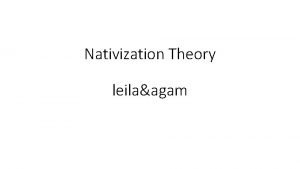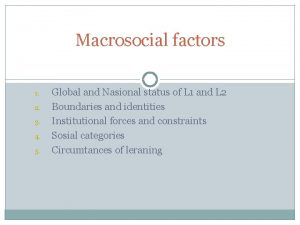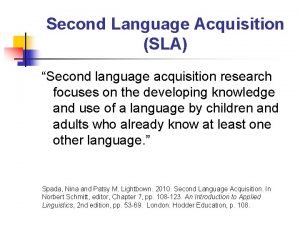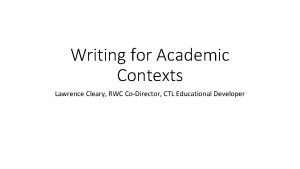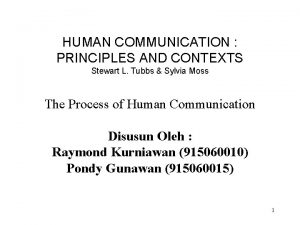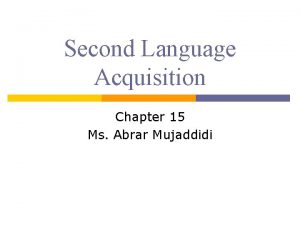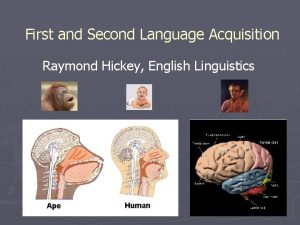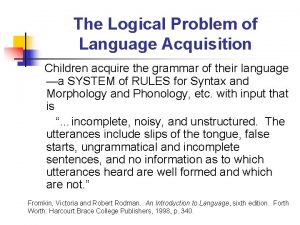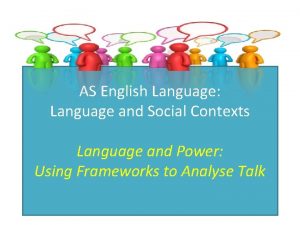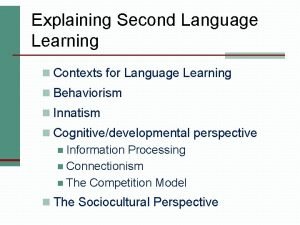Chapter Five Social Contexts of Second Language Acquisition

































- Slides: 33

Chapter Five: Social Contexts of Second Language Acquisition Ana, Amy, Mariana, and Taylin

Communicative competence “What a speaker needs to know to communicate appropriately within a particular language community” • Language community: a group of people who share knowledge of a common language or at least to some extent. • Involves knowing not only the vocabulary, phonology, grammar, and other aspects of linguistic structure but also when to speak (or not), what to say to whom, and how to say it appropriately.

Commutative Context Different context in which variable features in language may appear • Linguistic contexts: elements of language form and function associated with the variable element. • Psychological contexts: factors associated with the amount of attention which is being given to language form during production; the level of automaticity versus control in processing. • Microsocial context: features of setting/situation and interaction which relate to communicative events within which language is being produced, interpreted, and negotiated.

Input and Interaction • Krashen’s Monitor Model considers comprehensible input not only necessary but sufficient in itself to account for SLA.

Adaptations and Modifications

Examples Repetition: Teacher: “We will discuss poisonous snakes today at 2: 00. ” LL: “What” Teacher: “We will discuss snakes today. ” Paraphrase: Teacher: “This is a very poisonous snake with a lot of venom. ” LL: “What? ” Teacher“This is a dangerous snake”

Examples Expansion: LL: “Scary Snake” Teacher: “Yes this snake is very scary and dangerous, we should stay away from it. ” Clarification: LL: “This snake is venomous. ” Teacher: “What does venomous mean? ”

Difference in L 1 Learners and L 2 Learners L 1 learners cannot learn their first language by listening to tapes or recordings. L 2 learners CAN acquire at least some level of competence without interacting. (Not in all cases. )

Sociocultural Theory Interaction facilitates language learning. This theory suggests that learning occurs when symbolic meditation occurs. (when mental activities are transformed into more complex mental functions)

Zone of Proximal Development What a child can do without help and what a child can do with help. There are three sections. What the child knows on their own, What the child can figure out with some help, and what is beyond their comprehension.

Scaffolding Support given to a learner by an expert, scaffolding is used most when learning something new. Scaffolding

Interpersonal interaction Requires consideration of interpersonal interaction and communication that occurs within an individual own mind. When reading we draw interactively on our ability to decode print. Private speech is self talk which many children engage in, that leads to the inner speech, that more mature individuals use to control thought and behavior. Study of private speech when it is audible provides a window into the mind of sorts of researchers through which we can actually observe interpersonal interaction taking place and perhaps discover its functions in SLA.

Explaining why some individuals apparently interact quite successfully with others while developing little or no competence in a common linguistic code requires a closer look • Background knowledge and experiencing which help individual organize new information and make guesses about what is going on and what is coming up next • Understanding what is going on in an event or situation • Extralinguistic context including physical setting and objects • Knowledge of genre specific discourse structures : what rules for interaction are expected in a conversation lesson in school for example. • Gestures facial expressions and other nonverbal signs. • Prosodic features of tone and stress to convey emotional state.

• In spite of cultural differences in each of these elements there is often enough commonality to allow at least some level of meaningful communication between people who do not speak the same language to be able to cooperate and be willing to guess what the person is trying to say.

There are some individuals who are able to achive a relative advanced level of l 2 proficiency without the benefit of any interpersonal communication or opportunity to negotiate meaning in the lnaguage with others. Then there are some individuals who engage in extensive interaction with speackers of another language and they never learn the language to any significant degree.

Questions to consider • How does social contexts affect SLA? • How does identity, status, and values influence L 2 outcomes and why?

Factors to consider ● ● ● Global and national status of L 1 and L 2 Boundaries and identities Institutional forces and constraints Social categories Circumstances of learning

Global and National Status of L 1 and L 2 Languages spoken in a nation have both symbolic and political importance. When one language is spoken, it creates political cohesion and creates a sense of national unity for the citizens. For example, immigrants coming into the US are expected to learn English. It is a requirement for them to become citizens. They need English to be able to assert political processes, and for access to education and social services. It is often discouraged for immigrants to maintain their native language. The dominant group (English) may see it as threatening when immigrants assert pride in the ethnicity and maintain their native language.

Political identification and cohesion ● Second languages serve a political function in times of conquest and empire-building. For example: Post WWII domination by the Soviet Union brought Russian L 2 to much of Eastern Europe. ● Language is especially a source of cohesion for countries that are in the process of nation building. In the creation of Israel, Hebrew was to be learned by all immigrants, and if they spoke another language, they had social sanctions brought against them.

Need for L 2 learning is motivated on a global level by control of and access to resources and information.

Boundaries and Identities ● Linguistic boundaries often exist within and across national borders. They unify speakers as members of one language community, and exclude outsiders from insider communication. ● In order for a person to cross into another language community, they are required to learn that language, as well as learning the culture, values, and behavioral patterns of that community. This is called ACCULTURATION.

Social factors that affect SLA negatively • Dominance of one group over the other. • A high degree of segregation between groups. • Desire of the learner group to preserve its own lifestyle.

Institutional forces and constraints

Linguistic social control • There are official and unofficial policies that regulate which language is to be used in particular situations. For example: the use of the national language is required in political meetings and even such mundane acts as applying for permits or social services. • Then again, those running for political office will appeal to those they are attempting to represent (get votes from), then it is acceptable to use another language.

Linguistic forces and constraints (continued) ● It is detrimental for an L 2 learner in a legal situation who does not understand the language of the court. ● Family structures may disintegrate when the elders of the family speak their native language and the children become translators and brokers after learning the dominant language at school. This inverts the power structure and undermines parental authority. ● Access to education may be limited to minority language speakers. Most institutions require applicants to display competence in the dominant language

Social categories How are people categorized? • Age • Sex • ethnicity • Education level • Occupation • Economic status • These categories influence the experiences a person has, how they are perceived by others, and what is expected of them.

Age Young L 2 learners are more likely than older learners to acquire the language in a naturalistic setting as opposed to a classroom. They are more likely to use L 2 in social face-to-face situations, rather than just reading and writing. Those young learners who are not proficient in their L 1 tend to do less well than those who have had at least 2 years of schooling in their native language.

Sex Males and females have different attitudes and learning conditions, depending on their culture. Male children of immigrant farm workers seem to be more fluent in Spanish L 1 and better learners of English L 2. The boys were allowed to play outside with other children before attending school. While the girls had been kept inside to fulfill their responsibilities of caring for younger siblings and for their own safety.

On the other hand, female children had advantage over males in a classroom setting (study by Willett in 1995). The girls were allowed to sit together, support one another, and collaborate. The boy was kept apart from other boys due to behavior issues and he was not allowed to get help from his bilingual peers.

Ethnicity • • • Socially constructed attitudes from within native communities as a result of historic or current intergroup relations related to social boundaries and identities will influence SLA. Members of ethnic groups who perceive themselves to have much in common are more likely to interact, and thus are more likely to learn the other’s language. Religion and cultural backgrounds can also affect SLA.

Ethnicity and bilingualism outcomes Additive Bilingualism- members of a dominant group learn the language of a subordinate group without threat to their L 1 competence or to their ethnic identity. Subtractive Bilingualism- Members of a subordinate group lean the dominant language as L 2 and are more likely to experience some loss of ethnic identity and attrition of L 1 skills (especially children).

Education Levels Prior educational experience affect SLA. Children’s first experience with families, communities, and cultural environment all affect how a child will develop SLA. Informal vs. formal learning affects L 2 learning o Informal learning allows people to interact with speakers of another language o Formal learning takes place in schools that are established in accord with the needs, beliefs, values, and customs of their cultural setting. • •

• • “No individual factors in the macrosocial context of SLA can be isolated from others. Circumstances of learning are related to the nation that learner lives in and its history, culture, and geopolitical position, and to social and economic categorizations within the society, which in turn are related to historical, institutional, and political forces and constraints, all of which are related to and reflect or determine the status of the languages involved. The individual learner often has few or no choices in the matter of whether an L 2 will be available formal study, what language it will be, how it will be taught and at what levels. ”
 Acquisition vs learning examples
Acquisition vs learning examples What sociological perspective stresses that age
What sociological perspective stresses that age Denativization
Denativization Language
Language Language acquisition adalah
Language acquisition adalah 7 theories of second language acquisition
7 theories of second language acquisition Macrosocial factors
Macrosocial factors Language learning in early childhood
Language learning in early childhood роберт ладо
роберт ладо Theory of language development by chomsky
Theory of language development by chomsky Contrasting acquisition
Contrasting acquisition Krashens theory
Krashens theory Second language acquisition
Second language acquisition Contrastive analysis
Contrastive analysis Psycholinguistic aspects of interlanguage
Psycholinguistic aspects of interlanguage Language
Language Professional context
Professional context Uefap
Uefap Teachers in crisis contexts
Teachers in crisis contexts An srs document normally contains
An srs document normally contains Fairness and development global context
Fairness and development global context Intercultural communication in contexts
Intercultural communication in contexts Shape matching and object recognition using shape contexts
Shape matching and object recognition using shape contexts Model komunikasi tubbs and moss
Model komunikasi tubbs and moss Bolongie
Bolongie Difference between second language and foreign language
Difference between second language and foreign language Difference of first language and second language
Difference of first language and second language Difference of first language and second language
Difference of first language and second language 27 miles per gallon into kilometers per liter
27 miles per gallon into kilometers per liter Leveraging social media for talent acquisition
Leveraging social media for talent acquisition Social thinking social influence social relations
Social thinking social influence social relations Social thinking social influence social relations
Social thinking social influence social relations Logical problem of language acquisition
Logical problem of language acquisition The innateness theory
The innateness theory


